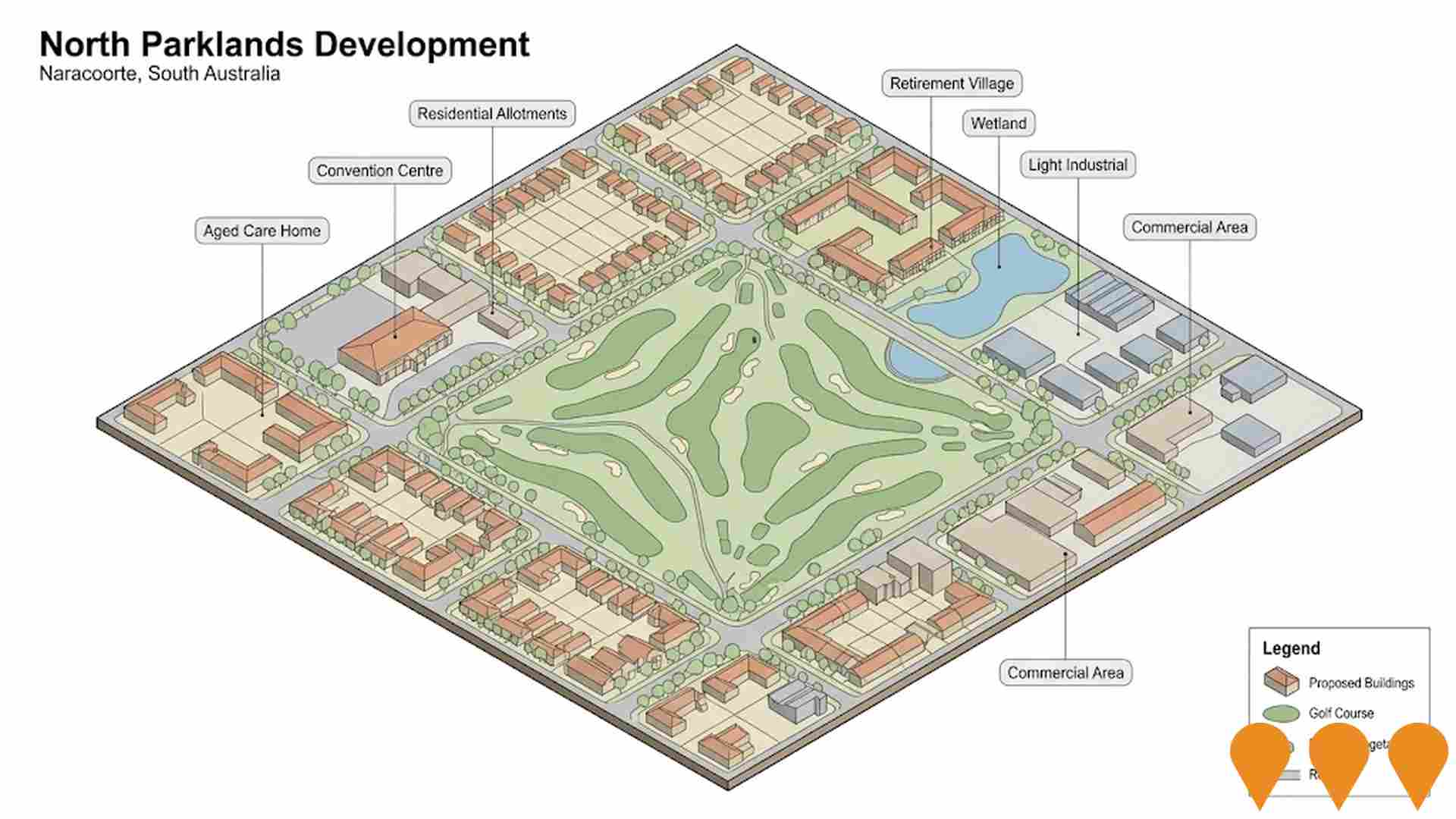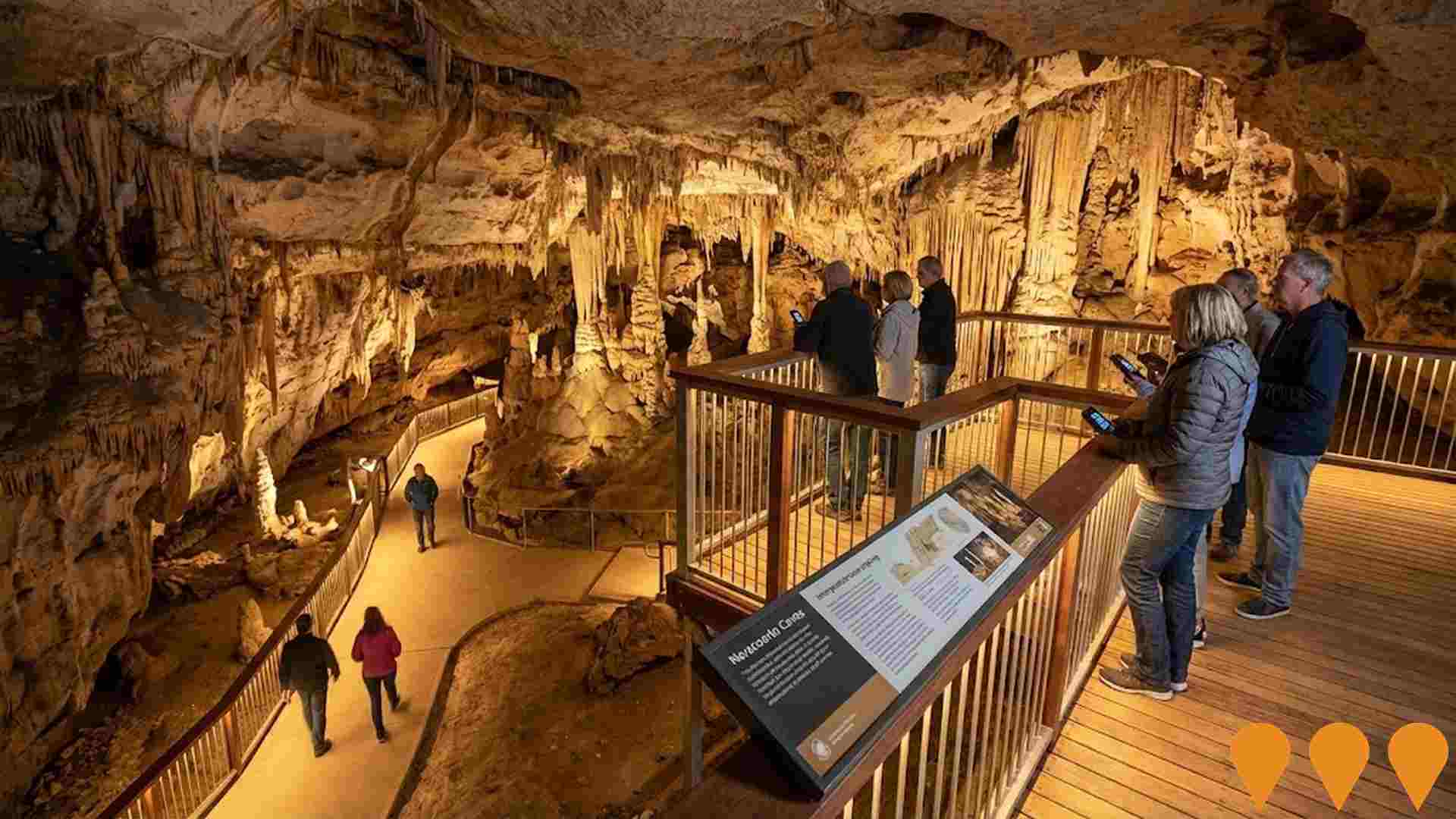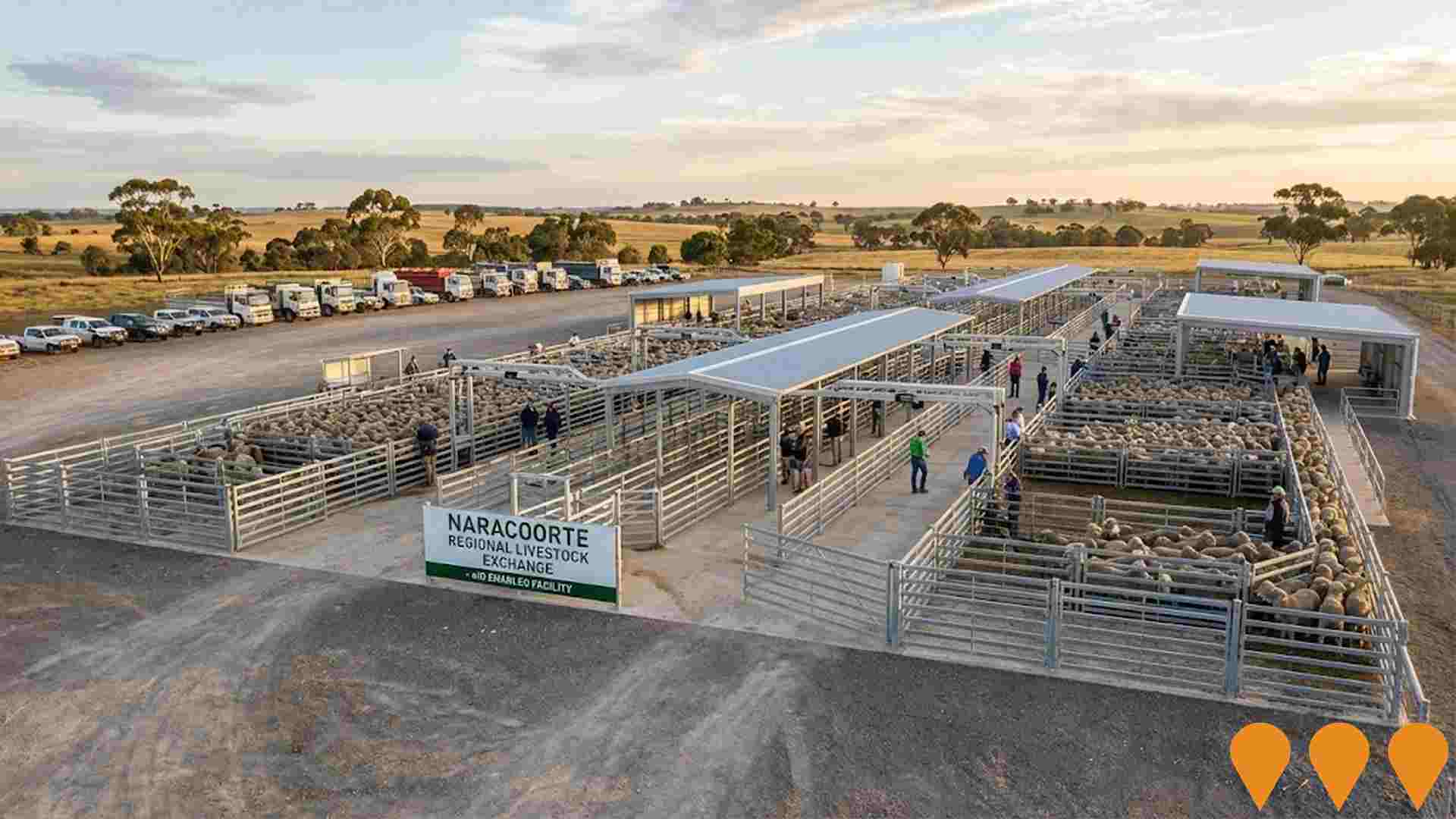Chart Color Schemes
est. as @ -- *
ABS ERP | -- people | --
2021 Census | -- people
Sales Activity
Curious about local property values? Filter the chart to assess the volume and appreciation (including resales) trends and regional comparisons, or scroll to the map below view this information at an individual property level.
Find a Recent Sale
Sales Detail
Population
An assessment of population growth drivers in Naracoorte Surrounds reveals an overall ranking slightly below national averages considering recent, and medium term trends
Naracoorte Surrounds' population is approximately 2,469 as of August 2025. This figure represents an increase of 74 people, a 3.1% rise since the 2021 Census which reported a population of 2,395. The change is inferred from the estimated resident population of 2,454 in June 2024 and an additional 32 validated new addresses since the Census date. This results in a population density ratio of 0.60 persons per square kilometer. Naracoorte Surrounds' growth rate of 3.1% since the census is within 2.3 percentage points of the SA3 area's growth rate of 5.4%, indicating competitive growth fundamentals. Natural growth contributed approximately 80.0% of overall population gains in recent periods.
AreaSearch uses ABS/Geoscience Australia projections for each SA2 area, released in 2024 with a base year of 2022. For areas not covered by this data and years post-2032, the SA State Government's Regional/LGA projections by age category are adopted, released in 2023 using 2021 data with adjustments made via weighted aggregation of population growth from LGA to SA2 levels. Future population dynamics anticipate lower quartile growth for national regional areas, with Naracoorte Surrounds expected to increase by 113 persons to 2041 based on the latest population numbers, representing a total increase of 4.0% over the 17 years.
Frequently Asked Questions - Population
Development
AreaSearch assessment of residential development drivers sees a low level of activity in Naracoorte Surrounds, placing the area among the bottom 25% of areas assessed nationally
Naracoorte Surrounds has recorded approximately 4 residential properties granted approval annually over the past five financial years, totalling 24 homes. In FY-26, 0 approvals have been recorded so far. On average, 2.3 people moved to the area per new home constructed between FY-21 and FY-25, reflecting robust demand that supports property values. New homes are being built at an average expected construction cost value of $427,000.
This year, $19.0 million in commercial approvals have been registered, indicating balanced commercial development activity. Compared to the Rest of SA, Naracoorte Surrounds records markedly lower building activity, 60.0% below the regional average per person. This limited new supply generally supports stronger demand and values for established dwellings. Development activity is also lower than nationally, reflecting market maturity and possible development constraints. Recent development has been entirely comprised of detached houses, preserving the area's low density nature and attracting space-seeking buyers.
The estimated count of 655 people per dwelling approval reflects its quiet, low activity development environment. Future projections show Naracoorte Surrounds adding 98 residents by 2041. At current development rates, new housing supply should comfortably meet demand, providing good conditions for buyers and potentially supporting growth beyond current population projections.
Frequently Asked Questions - Development
Infrastructure
Naracoorte Surrounds has emerging levels of nearby infrastructure activity, ranking in the 23rdth percentile nationally
Changes to local infrastructure significantly affect an area's performance. AreaSearch has identified seven projects likely to impact the region. Notable ones are North Parklands Development, Moyhall Road Reconstruction, Naracoorte High School Major Upgrades, and NRLE Sheep eID Infrastructure Upgrade. The following list details those most relevant.
Professional plan users can use the search below to filter and access additional projects.
INFRASTRUCTURE SEARCH
 Denotes AI-based impression for illustrative purposes only, not to be taken as definitive under any circumstances. Please follow links and conduct other investigations from the project's source for actual imagery. Developers and project owners wishing us to use original imagery please Contact Us and we will do so.
Denotes AI-based impression for illustrative purposes only, not to be taken as definitive under any circumstances. Please follow links and conduct other investigations from the project's source for actual imagery. Developers and project owners wishing us to use original imagery please Contact Us and we will do so.
Frequently Asked Questions - Infrastructure
North Parklands Development
A proposed $250 million mixed-use development over 25 years including 500 residential allotments around the Naracoorte Golf Course, a convention centre, motel-style serviced suites, a new aged care home, retirement village, wetland, light industrial services, and a commercial area, with existing features remaining untouched. Following community opposition and consultation in 2022, the Naracoorte Lucindale Council decided against supporting the unsolicited proposal, leading the developer to withdraw it. As of 2025, the area continues to function as the Naracoorte North Nature Park with no signs of development proceeding.

Major Upgrade to Visitor Facilities at Naracoorte Caves
Major upgrade to visitor facilities at the World Heritage listed Naracoorte Caves, including construction of a viewing platform, safety infrastructure, lighting, and extensions/improvements to trails to enhance the tourism experience.

NRLE Sheep eID Infrastructure Upgrade
Installation of new infrastructure and equipment at the Naracoorte Regional Livestock Exchange for sheep electronic identification to enhance livestock traceability and operational efficiency. The project, budgeted at approximately $2.34 million for 2024-2025, is nearing completion with upgrades to sheep yards and collaboration with PIRSA for implementation.

Wattle Range Council General Code Amendment
Comprehensive rezoning initiative affecting 9 sites across Wattle Range Council area (originally 10, with Site 8 Beachport removed following community feedback). The amendment includes rezoning of the Railway Precinct, Southern Ports Highway, and Employment Zones on Mount Gambier Road in Millicent, plus sites in Penola, Beachport, and Glencoe. This code amendment aligns with the Council's 25-year Strategic Land Use Plan adopted in August 2022, designed to facilitate sustainable residential, employment, and neighbourhood development while protecting agricultural land. Public consultation opened on August 29, 2025, with community drop-in sessions held throughout September 2025.

Naracoorte High School Major Upgrades
Major facility upgrade including refurbishment of art and design building with 3 general learning areas, 2 outdoor learning areas, amenities, and ancillary spaces; construction of new sports change rooms, amenities, agriculture learning space, and change block; refurbishment of home economics facility; and demolition of ageing infrastructure.

Naracoorte Workers' Accommodation Facility
Development of a workers' accommodation facility at the old TAFE site, including 43 single-storey cabins for 129 people, a small international grocery store, basketball and tennis courts, a pool, and food preparation areas. The project received approval in March 2023, but as of mid-2024, the site remains unused, and no construction has commenced. The site owner is now proceeding with a separate child care centre development on the same site, suggesting the workers' accommodation project may be stalled or abandoned.

Moyhall Road Reconstruction
Reconstruction of pavement and shoulders with new drainage and a full-width spray-sealed surface to address pavement failure, reduce maintenance costs, and improve road safety. Jointly funded with Naracoorte Lucindale Council under the Roads to Recovery Program.

Riddoch Highway Overtaking Lane
Planning is underway for the construction of a new southbound overtaking lane on the Riddoch Highway between Padthaway and Naracoorte to enhance road safety, improve efficiency for freight vehicles, reduce driver fatigue, and ensure consistent journey times. Key features include increased lane widths with a 1.4m wide centreline treatment, new pavement construction and surfacing, a new Weigh In Motion system, audio tactile line marking, and roadside hazard protection. This project is part of the South Australian Rural Roads Safety Package.

Employment
AreaSearch analysis of employment trends sees Naracoorte Surrounds performing better than 90% of local markets assessed across Australia
Naracoorte Surrounds had an unemployment rate of 0.8% as of June 2025. It employed 1,502 residents with a participation rate of 70.1%, compared to Rest of SA's 4.6% and 54.1% respectively.
Key industries were agriculture, forestry & fishing (3.8 times regional level), health care & social assistance (6.3%), and manufacturing. Between May 2024 and June 2025, labour force decreased by 2.3%, employment declined by 2.5%, causing unemployment to rise by 0.2 percentage points. National employment forecasts from Jobs and Skills Australia, released in May 2025, projected a 6.6% growth over five years and 13.7% over ten years. Applying these projections to Naracoorte Surrounds' employment mix suggested local growth of approximately 3.9% over five years and 9.6% over ten years.
Based on AreaSearch analysis of SALM and ABS data, the 12-month period saw labour force decreasing by 2.3% while employment declined by 2.5%, causing unemployment to rise by 0.2 percentage points. By comparison, Rest of SA recorded employment decline of 1.2%, labour force growth of 0.1%, with unemployment rising 1.2 percentage points. Jobs and Skills Australia's national employment forecasts from May 2025 can offer further insight into potential future demand within Naracoorte Surrounds. These projections, covering five and ten-year periods, have been mapped against the local employment profile to estimate growth patterns. While national employment is forecast to expand by 6.6% over five years and 13.7% over ten years, growth rates differ significantly between industry sectors. Applying these industry-specific projections to Naracoorte Surrounds's employment mix suggests local growth of approximately increase by 3.9%% over five years and 9.6% over ten years (please note this is a simple weighting extrapolation for illustrative purposes and does not take into account localised population projections).
Frequently Asked Questions - Employment
Income
Income levels sit below national averages according to AreaSearch assessment
Naracoorte Surrounds had a median taxpayer income of $50,095 and an average of $67,834 in the financial year 2022, according to postcode level ATO data aggregated by AreaSearch. This was higher than the national averages for median ($46,889) and average income ($56,582). By September 2025, estimated incomes would be approximately $56,522 (median) and $76,537 (average), based on a Wage Price Index growth of 12.83% since financial year 2022. In the 2021 Census, personal income ranked at the 63rd percentile ($874 weekly) and household income at the 43rd percentile. Income distribution showed that 35.2% (869 individuals) fell within the $1,500 - $2,999 range. After housing costs, residents retained 95.0% of their income, indicating strong purchasing power. The area's SEIFA income ranking placed it in the 6th decile.
Frequently Asked Questions - Income
Housing
Naracoorte Surrounds is characterized by a predominantly suburban housing profile, with above-average rates of outright home ownership
Naracoorte Surrounds' dwellings, as per the latest Census, were 98.0% houses and 2.0% other dwellings (semi-detached, apartments, 'other' dwellings), compared to Non-Metro SA's 87.6% houses and 12.5% other dwellings. Home ownership in Naracoorte Surrounds stood at 55.6%, with mortgaged dwellings at 25.7% and rented ones at 18.8%. The median monthly mortgage repayment was $900, lower than Non-Metro SA's average of $1,083, and the median weekly rent was $150, compared to Non-Metro SA's $205. Nationally, Naracoorte Surrounds' mortgage repayments were significantly lower at $900 versus Australia's average of $1,863, while rents were substantially below the national figure of $375.
Frequently Asked Questions - Housing
Household Composition
Naracoorte Surrounds has a typical household mix, with a higher-than-average median household size
Family households account for 75.9 percent of all households, including 34.0 percent couples with children, 37.3 percent couples without children, and 4.5 percent single parent families. Non-family households constitute the remaining 24.1 percent, with lone person households at 22.5 percent and group households comprising 1.3 percent of the total. The median household size is 2.5 people, larger than the Rest of SA average of 2.3.
Frequently Asked Questions - Households
Local Schools & Education
Educational outcomes in Naracoorte Surrounds fall within the lower quartile nationally, indicating opportunities for improvement in qualification attainment
The area's university qualification rate is 17.0%, significantly lower than the Australian average of 30.4%. This presents both a challenge and an opportunity for targeted educational initiatives. Bachelor degrees are the most common at 13.6%, followed by graduate diplomas (1.8%) and postgraduate qualifications (1.6%). Vocational credentials are prevalent, with 37.8% of residents aged 15+ holding them - advanced diplomas comprise 11.2% and certificates make up 26.6%.
Educational participation is high at 27.3%, including 13.0% in primary education, 8.4% in secondary education, and 1.6% pursuing tertiary education. The area has two schools serving 230 students - Lucindale Area School and Frances Primary School. These schools offer balanced educational opportunities, with an ICSEA score of 979, typical for Australian schools. There is one primary school and one K-12 school in the mix. The school places per 100 residents (9.3) are below the regional average (14.9), indicating some students may attend schools in nearby areas.
Frequently Asked Questions - Education
Schools Detail
Nearby Services & Amenities
Transport
Transport servicing is very low compared to other areas nationally based on assessment of service frequency, route connectivity and accessibility
Naracoorte Surrounds has one active public transport stop operating within its vicinity. This stop is serviced by a single bus route that provides ten weekly passenger trips in total. Transport accessibility in the area is limited, with residents typically located 29583 meters away from the nearest transport stop.
The service frequency averages one trip per day across all routes, equating to approximately ten weekly trips per individual stop.
Frequently Asked Questions - Transport
Transport Stops Detail
Health
Naracoorte Surrounds's residents are extremely healthy with very low prevalence of common health conditions across all age groups
Analysis of health metrics shows strong performance throughout Naracoorte Surrounds. The prevalence of common health conditions across all age groups is very low.
Approximately 53% of the total population (~1,318 people) have private health cover, compared to 49.4% across Rest of SA. The most common medical conditions in the area are arthritis and asthma, impacting 7.1% and 7.1% of residents respectively. A total of 73.4% of residents declared themselves completely clear of medical ailments, compared to 65.5% across Rest of SA. The area has 21.2% of residents aged 65 and over (522 people), which is lower than the 23.3% in Rest of SA. Health outcomes among seniors are particularly strong, performing even better than the general population in health metrics.
Frequently Asked Questions - Health
Cultural Diversity
The latest Census data sees Naracoorte Surrounds placing among the least culturally diverse areas in the country when compared across a range of language and cultural background related metrics
Naracoorte Surrounds had a cultural diversity index below average, with 89.4% of its population being Australian citizens, 93.7% born in Australia, and 98.0% speaking English only at home. Christianity was the predominant religion, accounting for 46.2%, compared to 42.9% across Rest of SA. The top three ancestry groups were Australian (35.0%), English (34.2%), and Scottish (10.3%).
Notably, German ancestry was overrepresented at 7.9% (versus 6.4% regionally), while Sri Lankan and Samoan ancestry had notable presence with 0.2% and 0.1%, respectively.
Frequently Asked Questions - Diversity
Age
Naracoorte Surrounds hosts an older demographic, ranking in the top quartile nationwide
Naracoorte Surrounds' median age is 44 years, slightly younger than Rest of SA's 47 but significantly higher than Australia's median of 38. The age profile shows that the 45-54 year-olds are particularly prominent at 13.7%, while the 75-84 group is smaller at 5.9% compared to Rest of SA. Post-2021 Census data indicates that the 75-84 age group grew from 4.7% to 5.9%. Conversely, the 25-34 cohort declined from 9.1% to 7.8%, and the 55-64 group dropped from 17.2% to 16.0%. Demographic modeling suggests that Naracoorte Surrounds' age profile will significantly evolve by 2041, with the 75-84 age cohort projected to expand by 118 people (81%) from 146 to 265. Senior residents aged 65 and above will drive 78% of population growth, highlighting demographic aging trends. Both the 15-24 and 5-14 age groups are expected to decrease in numbers.


